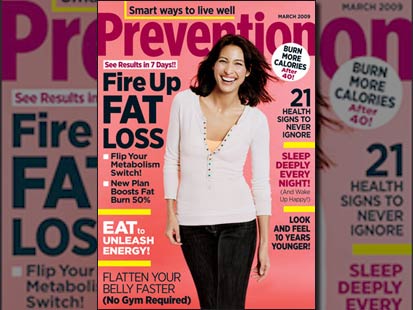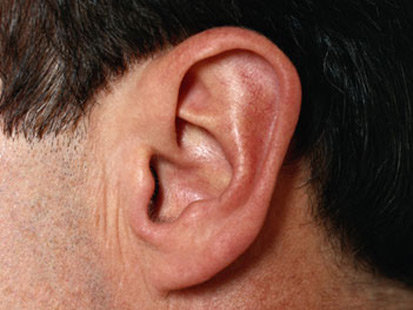The Odd Body Explained
Experts reveal the truth behind 13 of your body's lesser understood quirks.
1. What causes goose bumps?
Goose bumps (scientific name: piloerection) pop up when you're cold or afraid. A tiny muscle at the base of each body hair contracts; together, they appear as naked bumps on the flesh.
They made sense eons ago, when humans still had a natural "fur coat." Back then, fluffing your ruff would warm the body by trapping an insulating layer of air between the hairs. And standing your hair on end was intimidating to predators or enemies (picture a cat facing off with a dog).
Evolution has since stripped humans of their pelts. Now goose bumps are, of course, no medical issue. If you're uncomfortable showing off your vestigial physiognomy, dress warmly, place yourself in calm environments, and avoid horror flicks.

For more health tips, check out the latest issue of Prevention, on shelves now!
2. Why does chopping onions make you tear up?
When you cut into an onion, you rupture its cells, releasing enzymes that produce a gas called propanethial sulfoxide. Once that gas reaches your eyes, it reacts with tears to produce a mild sulfuric acid. And that hurts. The brain then signals the eyes' tear glands to produce more liquid to flush the stuff out. The more you chop, the more irritating gas you produce and the more tears you shed.
"The onion's chemical reaction is a defense mechanism that evolved to repel pests," explains University of Wisconsin–Madison horticultural professor Irwin Goldman, PhD.
Keep the stinging and crying to a minimum by chilling an onion in the freezer before cutting it; cold temperatures slow release of the enzymes. The highest concentration of enzymes is at the bottom of the onion, so cut it last to postpone the weeping (and the irritation) for as long as possible.
***
More from Prevention:
 Curious About Your Other Body Oddities?
Curious About Your Other Body Oddities?
 Keep Your Body Feeling Fabulous
Keep Your Body Feeling Fabulous
3. Why do your joints crack?
The most common type of joint in the human body is the diarthrodial joint -- knuckles and shoulders are examples -- in which two bones come together in a capsule. Inside that joint capsule is a lubricant called synovial fluid, which contains dissolved gases. When you stretch the joint, you're actually compressing it and the fluid within, forcing those nitrogen–rich gases to escape the synovial solution. The release of "air" within the joint capsule is what you hear as a "pop."
Once the gas is released, the joint is a bit more flexible (enabling you to go a little further in a yoga pose, for example). But you've probably noticed that you can't immediately crack the same joint again. That's because the gases released in a pop must first reabsorb into the fluid, a process that takes 15 to 30 minutes.
If you habitually crack your knuckles to relieve tension, try concentrating on your breath for 30 seconds instead. Knuckle cracking doesn't lead to arthritis, but it can lead to decreased grip strength.

4. When you find something really funny, why do you sometimes "laugh until you cry"?
Experts don't really know. One thing to consider: Laughing and crying are similar psychological reactions.
"Both occur during states of high emotional arousal, involve lingering effects, and don't cleanly turn on and off," says Robert R. Provine, PhD, a psychologist at the University of Maryland, Baltimore County, and author of Laughter: A Scientific Investigation. We associate crying with sadness, but tearing up is an even more complex human response. Tears are triggered by a variety of emotions -- "by pain, sadness, and in some cases even extreme mirth. It's just the way we've evolved," says Lee Duffner, MD, a professor of ophthalmology at the University of Miami's Bascom Palmer Eye Institute.
As it turns out, that's good, because both laughter and crying can ease a stressful experience, probably by counteracting the effects of cortisol and adrenaline. So if you ever find yourself laughing until you cry, count yourself lucky.
***
More from Prevention:
 Curious About Your Other Body Oddities?
Curious About Your Other Body Oddities?
 Keep Your Body Feeling Fabulous
Keep Your Body Feeling Fabulous
5. What makes your eyelid twitch?
This annoyingly common condition is known as eyelid myokymia. Not a lot is known about eye twitches, which are more likely to occur in the lower eyelid than in the upper, though they're probably caused by the misfiring of a nerve. But experts know that fatigue, stress, and caffeine all increase the likelihood of the pesky twitching. So do eyestrain, poor nutrition, excessive alcohol intake, and allergies.
Fortunately, eye twitching is almost always benign and usually goes away by itself. To put an end to a bout of the eye flutters, cut down on coffee and alcohol and give your eyes -- and your whole body -- a good night's rest.

6. Why do some people always feel cold?
Body temperature is regulated in the brain by the hypothalamus, which signals the body to give off heat in warm conditions and trap heat (or shiver, generating heat in muscles) when it's cold.
Iron plays a role in this process, so people with anemia (commonly caused by iron deficiency) often feel chilly. Poor circulation -- due to high blood pressure or medications, among other culprits -- can leave the extremities deprived of heat. An underactive thyroid gland can also slow a person's metabolism to a point where the body generates insufficient warmth.
A recent study suggested there may even be a genetic predisposition to toward tolerance of cold. If you're the type who needs to wear sweaters and wool socks in the summer, eat iron-rich foods like lean red meats, beans, and dark green leafy vegetables, which can counter anemia. And avoid nicotine, which constricts blood vessels and leads to poor circulation.
***
More from Prevention:
 Curious About Your Other Body Oddities?
Curious About Your Other Body Oddities?
 Keep Your Body Feeling Fabulous
Keep Your Body Feeling Fabulous
7. Is it true that your ears grow throughout life?
Yes, the outer ears do. Starting at birth, the ears are, proportionally, the body's largest feature, with a Spock-like prominence. They grow rapidly until about age 10, then slow to the languid pace of about 0.22 millimeter per year, according to a study by Britain's Royal College of General Practitioners.
Other studies show that the earlobe itself also lengthens throughout life (men have longer lobes than women). However, the size of the ear canal, which is formed by bone and cartilage, does not increase into old age.

8. Is it true that all babies are born without a single freckle?
Babies, of course, can be born with birthmarks and "beauty marks," but it's true that upon entering the world they have no freckles, which the skin produces (using excess pigment) in response to sun exposure. As babies get out in the sun, those with fair complexions and light eyes will be especially prone to developing freckles (and will have a higher likelihood of skin cancer and melanoma later in life).
"Those freckles on the redheaded kid's cheeks aren't cute -- they're sun damage," says Robin Ashinoff, MD, director of dermatologic surgery at Hackensack University Medical Center. "And freckles probably also indicate damage to the DNA in your skin cells."
Children and adults alike should have their freckles monitored regularly by a dermatologist and vigilantly use sunscreen of SPF 30 or higher.
***
More from Prevention:
 Curious About Your Other Body Oddities?
Curious About Your Other Body Oddities?
 Keep Your Body Feeling Fabulous
Keep Your Body Feeling Fabulous
9. What causes the feeling of "pins and needles"?
Called paresthesia, pins and needles are caused by blocked blood flow to a pressed nerve. If you sit too long in an awkward position - -or even just with your legs crossed -- you may press hard enough on a nerve to interrupt its signaling to the brain, causing your feet, for example, to "fall asleep," or go numb.
This is not the same as a pinched nerve, a longer-lasting condition that occurs when a part of the body, swollen because of injury or misalignment, applies steady pressure on a nerve.
Paresthesia is usually felt in the extremities -- hands, feet, and ankles. That crazy-making prickly sensation is the resumption of pain messages to the brain. Simply changing your position is almost always enough to allow the nerve to resume communication. But prickly feelings more rarely can be symptoms of diseases as diverse and serious as diabetes, lupus, and MS. If your pins and needles don't resolve quickly with a change of body position, see a doctor.

10. Why are there rings or halos around lights when you drive at night?
This phenomenon falls under the category of "spherical aberration" -- just one of several examples of how the human eye is optically imperfect. In daylight, the pupil narrows to a very small opening, allowing light to hit the very center of the lens. At night, when the pupil dilates dramatically to allow maximum light to enter, your eye is using a much larger swath of its lens to see.
"The farther out on the lens you go, the less perfect the optics are," says Duffner. "And as you get off center, those light rays won't be focused to the center of the eye."
You see circles, well, because your lens is round. Almost everyone sees these rings, and if you've always seen them, you're probably just fine, he says. But halos can also be caused by opacities in the lens -- a sign of cataracts. So if seeing halos is new to you, see a doctor for a cataract exam.
***
More from Prevention:
 Curious About Your Other Body Oddities?
Curious About Your Other Body Oddities?
 Keep Your Body Feeling Fabulous
Keep Your Body Feeling Fabulous
11. Can "cankles" actually be good for you?
Maybe. Scientists haven't studied the significance of ankle shape, but other research on fat distribution may point to an answer.
Ankles that have lost a bit of definition over the years and appear to merge with the calf (hence the hybrid word) might actually improve your health profile, as long as you're not seriously overweight. Fat stored in the intra-abdominal region -- in and around the organs -- correlates highly with metabolic disorders, such as type 2 diabetes; fat in the legs is least linked with these maladies.
Wendy Kohrt, PhD, professor of medicine at the University of Colorado Denver, found that postmenopausal women who had a relatively high level of leg fat (as opposed to abdominal fat) had lower risks of heart disease, hypertension, and type 2 diabetes. Leg fat, she explains, may protect postmenopausal women by drawing triglycerides out of the bloodstream, where they constitute a risk factor, and into fat deposits in the legs and, possibly, cankles. Her findings suggest that removing lower-body fat cells -- by liposuction, say -- may not be a good idea: Women who do may begin to add weight to fat cells in the more dangerous midriff zone, she suspects.

12. How could chewing sugarless gum and eating cheese prevent cavities?
Every time you eat, bacteria in your mouth react chemically with the food and introduce an organic acid that can cause tooth decay. By dislodging food, rinsing teeth, and diluting acid, saliva counters this process. The key is to keep it flowing, which is where chewing gum -- or at least chewing -- comes in.
"We showed that the simple mechanical act of chewing stimulates salivary flow," says James Wefel, PhD, director of the Dows Institute for Dental Research.
As for cheese, its fats may act as a protective barrier for the teeth; it also contains calcium and phosphate, which may discourage decay and strengthen teeth. What this all means to you: Limit between-meal nibbles, thereby reducing the number of acid exposures. Chew sugarless gum after meals. Or do like the French and finish your meal with a few pieces of cheese.
***
More from Prevention:
 Curious About Your Other Body Oddities?
Curious About Your Other Body Oddities?
 Keep Your Body Feeling Fabulous
Keep Your Body Feeling Fabulous
13. Why does your side hurt sometimes when you laugh really hard?
Two classic causes of a "side stitch" are running and prolonged laughter. Those activities have at least one thing in common: exertion of the diaphragm.
"When you laugh really hard, you're sucking in a lot of air, which fills the lungs and pushes down on the diaphragm while the abdominal muscles are also contracting and pushing up on the diaphragm," explains Robert Gotlin, DO, a sports physician at Beth Israel Medical Center and former director of orthopedic rehab with the New York Knicks. All of which, of course, happens scores of times each minute when you're howling. The repeated compression can produce a muscle spasm that we all know as a stitch.
"Sometimes when you laugh a lot, you get a pain in your right arm as well as the side stitch. That's because the nerve that supplies the diaphragm also goes to the right shoulder," he says.
So, in addition to busting your gut, a hearty laugh can mistakenly make you think you're having a heart attack. Try breaking the rapid cycle of diaphragm punishment that we call laughter by slow, deep breathing between fits of hysteria. And avoid eating big meals, which draw blood to the stomach, before settling in for an evening of 30 Rock reruns.

***
More from Prevention:
 Curious About Your Other Body Oddities?
Curious About Your Other Body Oddities?